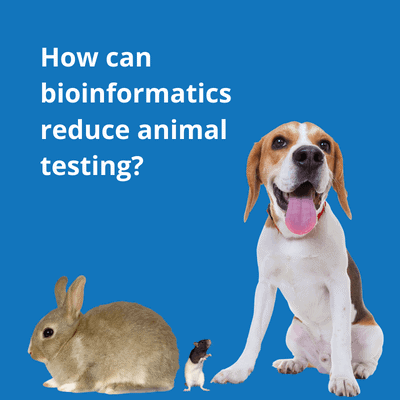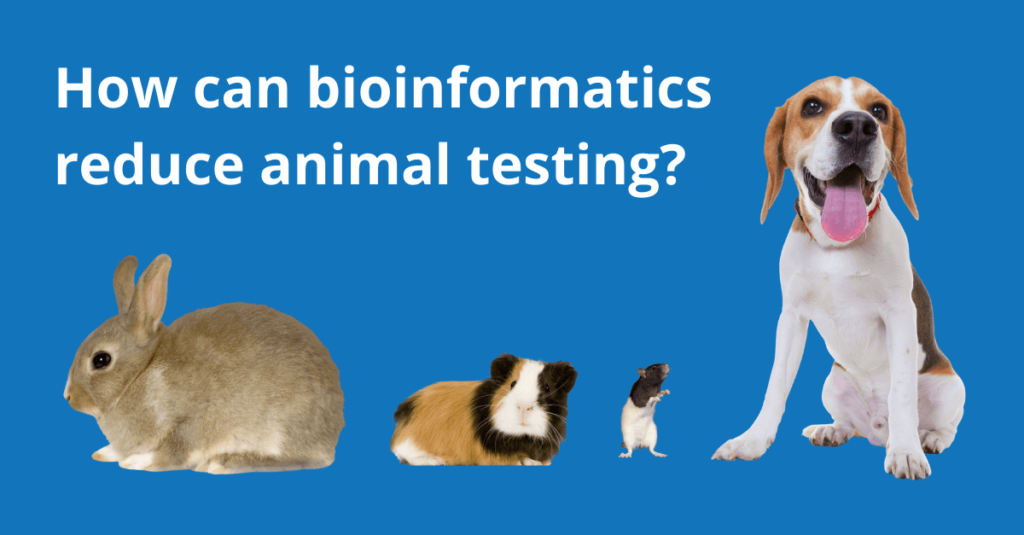How to Reduce Animal Testing with Bioinformatics
- 13th October 2023
- Posted by: Breige McBride
- Category: Bioinformatics

The question of how to reduce animal testing is considered now more than ever. Not only by ethically-conscious consumers who want to avoid products tested on animals, but also by governments and industry, where there is an increased focus on reducing animal testing.
Although many countries, including those in the European Union and United Kingdom, have banned the use of animal testing for cosmetic product development, animal testing is mandated in industries other than cosmetics in order to create safe and effective medications for humans.
However, many countries including the United Kingdom, United States and Australia, are trying to limit their use of animal testing across all industries. These countries demonstrate this via their commitment to embracing the 3Rs of animal research, which are:
- Replace: where possible, replace the use of animals in research with other research techniques
- Reduce: when animal testing is necessary, reduce the number of animals used as much as possible
- Refine: refine the care of research animals to keep pain and suffering to a minimum
Indeed, in the pharmaceutical industry, the 3Rs have recently come into sharper focus, with the problem of animal testing and how to replace it top of mind now more than ever. This is due to the introduction of new legislation in 2022 from the U.S. Food and Drug Administration (FDA). The new legislation states that new medicines do not necessarily need to be tested in animals in order to receive FDA approval. This is a significant step-change for the pharmaceutical industry which will help it to reduce and prevent animal testing in the future.

Preventing animal testing with bioinformatics
Animal testing happens in many industries. Here we will focus on how the pharmaceutical industry can reduce animal testing with bioinformatics, but we will also touch on how bioinformatics can help other industries, such as the agriculture, cosmetics and chemical industries, to do the same.
How to reduce animal testing in the pharmaceutical industry
Now that new medicines do not need to be tested on animals to be approved for use in the U.S. it is a great time for the pharmaceutical industry to look at how they can reduce animal testing by using bioinformatics and other in silico approaches.
There are many ways bioinformatics approaches can help the pharmaceutical industry to prevent animal testing throughout drug discovery and development. Let’s take a look at these below:
Drug target identification
Bioinformatics can help pharmaceutical companies to identify potential drug targets by analysing data from patients such as genomic and proteomic profiles. Such analysis allows researchers to assess specific targets at the molecular level which allows compounds to be more effectively designed. Identifying the correct targets earlier, in turn, reduces the number of drug compounds that need to be tested in animals.
Replacing animal models with in-silico models
Bioinformatics enables the creation of in-silico models (computer models) that simulate biological processes such as protein-protein interactions. These models allow researchers to predict how substances will behave in humans, reducing the need for animal testing for this purpose. In order to reduce animal testing as much possible, the pharmaceutical industry needs to utilise alternative approaches wherever it can.
Toxicity prediction
When pharmaceutical companies develop drugs, they need to ensure the drug won’t be toxic to those who take it. They ensure this via toxicity prediction studies. Toxicity prediction studies often use animal testing to assess the harmful effects of substances in living organisms. However, with bioinformatics we can analyse genomic and proteomic data to help predict how toxic a substance will be. Therefore, bioinformatics can reduce the need for animal testing to assess toxicity.
Pathway analysis
Bioinformatics tools can identify and analyse the biological pathways affected by different substances. Since this information helps researchers to understand how drugs might impact the human body this is another area where bioinformatics can replace, or reduce the need for, animal testing.
Comparative genomics
Bioinformatics approaches allow us to compare the genomic data of animals and humans. Since this helps us to better understand the similarities and differences between humans and animals, it can help prevent animal testing where it would not be beneficial.
Preventing animal testing in other industries
Chemical Industry
As is the case in the pharmaceutical industry, bioinformatics can also be used by the chemical industry to help with toxicity assessment. By enabling the analysis of chemical structures and the potential toxic effects they could have, bioinformatics can reduce the need for animal testing in chemical safety evaluation.
Agriculture Industry
The agriculture industry can use bioinformatics tools to analyse genetic information in order to optimise breeding programs. Using bioinformatics in this way reduces the need for animal testing to assess the traits of livestock.
Cosmetics Industry
Although many countries have banned animal testing for cosmetics, it is still prevalent in the cosmetics industry as a whole.
So it is still important to find ways of preventing it. Thankfully, bioinformatics can help. With bioinformatics models researchers can predict skin and eye irritation potential via the analysis of chemical structures. Therefore, the cosmetics industry can use such models to replace animal testing for assessing a cosmetic product’s irritation potential.
Conclusion
Although animals are still heavily relied upon for research across many industries, there is movement towards change. Significant changes have already been made, particularly in the cosmetics industry due to the availability of alternatives. Change is also happening in other industries, thanks to many countries championing the 3Rs of animal research.
What’s more, it is also clear that further changes are on the horizon. For example, the FDA dropping the requirement for animal testing for new medicine will allow the pharmaceutical industry to greatly reduce its use of animal testing. Of course, it will take the industry time to adapt and develop new techniques that will eliminate the need for animal testing completely. However, thanks to bioinformatics, there are already many ways that the pharmaceutical industry can reduce its reliance on animal testing. The next step for all industries that use animal testing is to adopt bioinformatics solutions into their workflows, wherever these solutions will reduce the need for animal testing.
Author: Breige McBride, Content and Social Media Manager, Fios Genomics
Reviewed by Fios Genomics Bioinformatics Experts to ensure accuracy
See Also
Agriculture Bioinformatics: Advance Your Agriculture Research
Advancing Cosmetic Development With Bioinformatics
National Centre For The Replacement, Refinement And Reduction Of Animals In Research
Fios Genomics on YouTube

